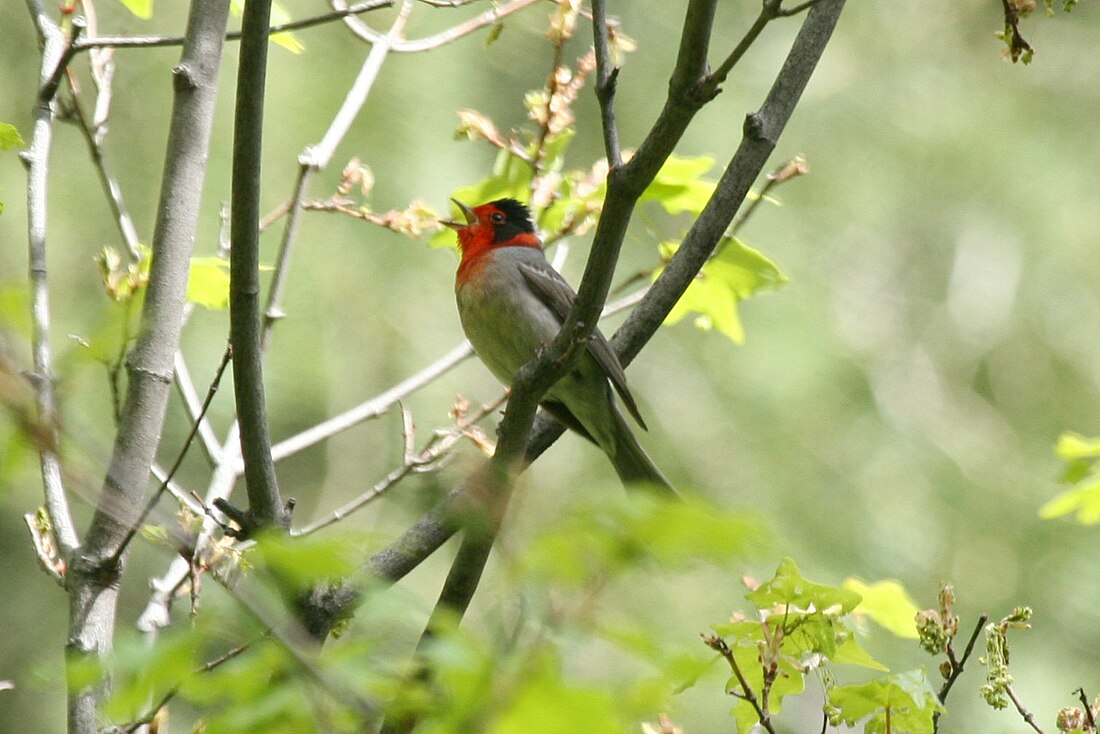Top Qs
Timeline
Chat
Perspective
Cardellina
Genus of birds From Wikipedia, the free encyclopedia
Remove ads
Cardellina is a genus of passerine birds in the New World warbler family Parulidae. The genus name Cardellina is a diminutive of the Italian dialect word Cardella for the European goldfinch.[2]
Remove ads
Taxonomy
Summarize
Perspective

The genus was introduced by the French naturalist Charles Lucien Bonaparte in 1850.[3] The type species was subsequently designated as the red-faced warbler.[4][5] The genus originally contained one species, the red-faced warbler. A comprehensive study of the wood-warblers published in 2010 that analysed mitochondrial and nuclear DNA sequences found that the five species formed a discrete clade, with the Wilson's and Canada warblers as early offshoots, followed by a lineage that gave rise to two branches – one leading to the red-faced and another that diverged to the red and pink-headed warblers.[6]
Spencer Fullerton Baird described the genus Ergaticus in 1865, using it to separate several species from what he felt was the closely related genus Cardellina,[7] and eventually subsumed into Cardellina in 2011. Prior to the creation and widespread acceptance of this genus, the red warbler and pink-headed warbler were placed in various other warbler genera, including Setophaga (with the American redstart), Cardellina (with the red-faced warbler), and Basileuterus (a widespread genus of tropical warblers) — as well as the Old World warbler genus Sylvia and the Old World tit genus Parus.[8] Recent DNA analysis shows that Ergaticus falls comfortably within the New World warbler clade, along with 18 other genera. It is closest to the genus Cardellina, with which it shares a common ancestor, and slightly more distantly related to the genus Wilsonia.[9]
There are two sister species, separated by the low-lying Isthmus of Tehuantepec, in the genus. The red warbler, C. ruber, is found in the Mexican highlands north of the isthmus. Its three subspecies, which differ slightly in appearance, are found in three disjunct populations. The pink-headed warbler, C. versicolor, is found south of the isthmus, in the highlands of Chiapas, Mexico and western Guatemala. It is monotypic across its limited range.[10] Though they are separated by geography and differ considerably in plumage, the two have sometimes been considered to be conspecific.[11]
Ergaticus is the Latinized version of the Ancient Greek ergatikos, meaning "willing or able to work".[12]
Remove ads
List of species
The following five species are currently recognized.[13]
Remove ads
Description
These are medium-sized warblers, measuring 12.5–13.5 cm (4.9–5.3 in) in length,[nb 1][10] and weighing 7.6–10 g (0.27–0.35 oz); the pink-headed warbler is, on average, slightly the heavier of the two.[11] As adults, their overall color is red, with duller wings and tails; juveniles are tawny-brown, with slightly paler underparts. The red warbler has white or silvery-gray ear patches (the color depends on the subspecies), while the pink-headed warbler's head and chest are silvery-pink. The sexes are similar in both species.[11] They have long, rounded wings and fairly long, rounded tails. They have small, narrow bills, with rictal bristles that extend more than halfway down their length.[8]
Habitat and range
Both the pink-headed and red warblers are birds of highland forest.[10] The red warbler is found from 2,000 to 3,500 m (6,600 to 11,500 ft) above sea level, and the pink-headed warbler from 2,000 to 3,800 m (6,600 to 12,500 ft).[11]
Notes
References
Wikiwand - on
Seamless Wikipedia browsing. On steroids.
Remove ads






